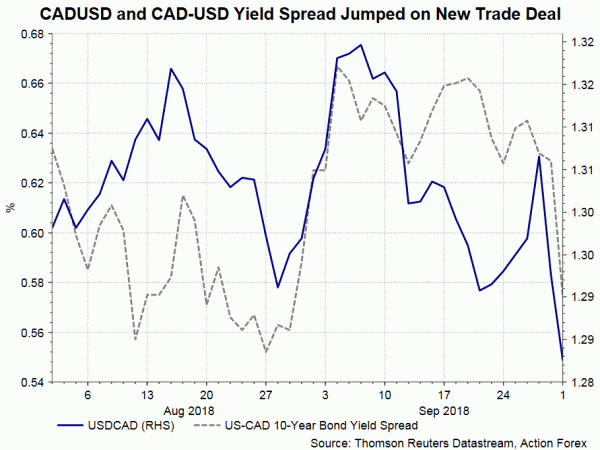Canada and the US eventually reached a preliminary trade deal, named USMCA, just a few hours before the US-imposed negotiation deadline. Obviously, the market was thrilled by the “breakthrough”, evidenced by the rally of Canadian dollar and, to a lesser extent, Mexican peso against the greenback. While there are new ingredients in the trade deal, we see it as largely a repackaged NAFTA.
The optimistic market reaction was mainly on elimination of uncertainty, instead of enhanced mutual benefit on trade. The agreement will need the US Congressional vote, which will not materialize. Therefore, the overhang is now the November midterm election. The hurdle to pass the bill would increase should the Democrats regain control of the House of Representatives.
Canada’s Red Line Not Crossed
As we mentioned shortly after the Mexico-US deal was reached, Canada would not compromise on Chapter 19 (Dispute settlement mechanism for countervailing and antidumping duties) in the original NAFTA. While not part of the Mexico-US deal, Chapter 19 is retained and has become Chapter 10 in USMCA.
Yet, Canada has made some concessions. It had agreed to open 3.5% of the dairy market for US access and to remove Class 6 and Class 7 milk categories within 6 months and the import quotas will be phased in over 6 years. Indeed, the US is already to access to 3.25% of Canada’s dairy market under the Comprehensive and Progressive Agreement for Trans-Pacific Partnership (CPTPP). Meanwhile, Class 7 of Canada’s milk category was just introduced last year for pricing milk ingredients like protein concentrates, skim milk and whole milk powder.
The US guarantees not to impose tariffs on automotive products (Section 232) as long as Canada caps is passenger vehicles exports at 2.6M per year and US$32.4B in parts (light trucks are exempt). These figures would not affect Canada’s auto market in reality as the country currently produces just under 2M light vehicles for domestic and export markets although. It exports about US$16B in parts. Note that the US has retained the threat on tariffs on steel and aluminium. It might be resolved with the quota system as in auto tariffs.
The new deal has touched upon issues on intellectual property laws with regards to ecommerce and pharmaceuticals. This can be considered as extension of the original plan. All in all, the new deal has returned the trade relations of the countries to the pre-Trump era with limited enhancement.
Endeavor to Curb China’s Exchange Rate Depreciation?
We are, however, astonished by Chapter 33, a clause to deal with “Macroeconomic Policies and Exchange Rate Matters”. According to Article 33.5, each party shall disclose publicly:
- monthly foreign-exchange reserves data and forward positions according to the IMF’s Data Template on International Reserves and Foreign Currency Liquidity, no later than 30 days after the end of each month;
- monthly interventions in spot and forward foreign exchange markets, no later than seven days after the end of each month;
- quarterly balance of payments portfolio capital flows, no later than 90 days after
the end of each quarter; and - quarterly exports and imports, no later than 90 days after the end of each quarter.
We doubt if the rules target the three parties involved as all of them are adopting free floating exchange rate regime. Trump’s administration probably tries to make it a precedent in negotiating trade deals with countries it deems are keen on currency manipulation. To be more explicit, we believe the White House has prepared to use similar terms as it negotiates trade deal with China in the future.














